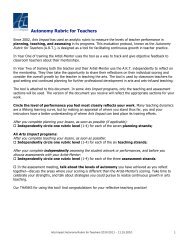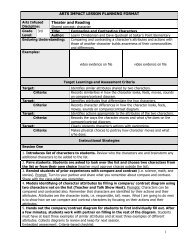Reading Theatrical Pictures.pdf - Arts Impact
Reading Theatrical Pictures.pdf - Arts Impact
Reading Theatrical Pictures.pdf - Arts Impact
Create successful ePaper yourself
Turn your PDF publications into a flip-book with our unique Google optimized e-Paper software.
ARTS IMPACT LESSON PLANNING FORMAT<br />
<strong>Arts</strong>-Infused Theater/<strong>Reading</strong><br />
Disciplines:<br />
Grade K Title: <strong>Reading</strong> <strong>Theatrical</strong> <strong>Pictures</strong><br />
Level:<br />
Author: Amy Svetich and Gail Frasier at Shoultes Elementary<br />
Enduring Understanding: <strong>Reading</strong> pictures can help develop understanding of what is going on<br />
in a story.<br />
Examples:<br />
video evidence on file<br />
Target Learnings and Assessment Criteria<br />
Target:<br />
Criteria:<br />
Target:<br />
Criteria:<br />
Identifies characters and setting within a nursery rhyme.<br />
Creates body shapes, facial expressions and levels from nursery<br />
rhyme to illustrate what is happening.<br />
Identifies how actors have used their body to depict a nursery rhyme.<br />
Makes verbal comments to connect tableau elements to what is<br />
happening in the nursery rhyme.<br />
Instructional Strategies<br />
Lesson Prep: Reads the nursery rhyme “Mary Had a Little Lamb” the two days before. Pre-selects<br />
groups that will perform each tableau.<br />
1. Introduces lesson and guides warm-up of “Walk About Statues.” Introduce the purpose of<br />
the lesson. Guides students as they move through the room in actor neutral. Tells students to freeze<br />
and make statues of characters and settings from “Mary Had a Little Lamb”. Prompts: <strong>Reading</strong><br />
pictures helps you understand what is going on in a story. Eventually you will read words like you<br />
read pictures. Today we’re going to create acting pictures that will help us understand what is<br />
happening in “Mary Had a Little Lamb.” Let’s start by getting our brains and bodies into the Nursery<br />
rhyme. Find a spot in the room to stand in actor neutral and stand as yourself. (Students find spot.)<br />
Walk around the room in actor neutral. When you hear a clap, change walking direction. (Students<br />
walk and change directions as prompted.) When I call out freeze, freeze in motion. (Students freeze.)<br />
And walk around the room in actor neutral. (Students walk.) Now when I say “Freeze” I’m going to<br />
tell you to create a statue. “Freeze” now, create a statue of Mary. 1-2-3- “freeze.” (The count is for<br />
students to get into statue. The freeze cues them to freeze in whatever character shape they are in.)<br />
And walk around the room in actor neutral. (Continue this same statue process with the lamb,<br />
children laughing and playing, the teacher, the principal, the school house. Perhaps incorporate<br />
different levels for statues.) Student walks around room in neutral creating frozen statues when<br />
prompted. Freezes and creates a statue displaying a given person, place, or thing.<br />
2. Introduces tableau. At the end of the walk about, the last prompt will flow into tableau<br />
introduction. Students stand in neutral and create statues for playing on the playground. Guides<br />
students to sit in circle area. Teacher pulls 3 or more students with dynamic statues and puts them<br />
together for a tableau. Instructs on tableau: a still, frozen picture with the elements of: body shapes,<br />
facial expression, and levels. Prompts: “Freeze” - create a statue of playing on a playground. 1-2-3<br />
Freeze. Actors relax. Come sit in the circle area. May I have the following students display their<br />
statues once more in front of the group? I’m going to arrange you into a frozen picture. Together<br />
these three statues create what we call a tableau, which is a still, frozen picture like a photograph or<br />
1
drawing. I’m going to spotlight their actions looking at tableau elements of facial expression, body<br />
shapes and levels. What action is Gerardo doing on the playground? (Continue questioning with other<br />
statues in tableau covering all tableau elements.) Selected student actors work with teacher putting<br />
statues into a tableau. Audience offers suggestions. Gives 1-2-3 clap to show appreciation for actors.<br />
3. Guides students to create tableaux in pre-selected groups. In groups, students work on<br />
teacher chosen stanzas of “Mary Had a Little Lamb”. Students decide how their group will act out<br />
their tableau using the elements (body shapes, levels, and facial expressions). The teacher will walk<br />
around and work with groups as needed. Student works in group to create tableau.<br />
4. Sets students up for audience participation. Review audience etiquette and focus students to<br />
look for tableau elements. Prompts: The audience is expected to sit quietly and have eyes on the<br />
performers during presentation. As an audience your job is to look for the tableau elements of facial<br />
expressions, body shapes and levels. Student listens and contributes ideas on how to be a good<br />
audience.<br />
5. Guides students in performance. Audience reflects after each group. Prompts: Each group<br />
will perform and then we will discuss the tableau elements that we noticed and how these help us<br />
understand what is happening in the story. The first group will perform and I will ask them to freeze.<br />
While frozen, I will read their part of the Nursery rhyme. The performers will stay in their frozen<br />
tableau while I spotlight each character. After that I will ask the audience to reflect the tableau<br />
elements. Group1 please come into the performance space. 1-2-3 Freeze (read stanza). Actors stay<br />
frozen (spotlight a character- If students have a difficult time staying frozen, let them sit until they are<br />
spotlighted). Audience, who is this character? What are they doing to show they are that character?<br />
What facial expressions tell you that? What are they doing with their bodies to show you that? What<br />
level is this character at why? (Repeat this reflection for the remaining characters in group.). Actors<br />
relax. Now the actors will repeat their tableau as we all recite their part of the rhyme together (do<br />
this). Actors relax. Let’s appreciate our actors- 1-2-3- Clap (repeat this process for all groups).<br />
Student as actor, freezes in tableau with group members. As audience, reflects on tableau elements<br />
portrayed by actors and recites nursery rhyme. Embedded Assessment: Criteria-based teacher<br />
checklist.<br />
6. Guides whole class reflection. Students sit in a circle. Ask reflection questions and selected<br />
students respond. Prompts: Tell me something that you saw in one of the tableaux. How did this<br />
help you to understand what was happening in the nursery rhymes. Student sits in circle. Some<br />
volunteer reflections based on question. Students respond throughout the day.<br />
Embedded Assessment: Peer criteria-based assessment<br />
2
Vocabulary<br />
Resources:<br />
Historical Art or<br />
Performance<br />
Classroom, Visual<br />
<strong>Arts</strong> or Performing<br />
<strong>Arts</strong> Materials<br />
WA Essential<br />
Learnings<br />
Theater<br />
• actor neutral<br />
• emotion<br />
• freeze<br />
• shapes, (facial<br />
expression, levels)<br />
• statue<br />
• tableau (body)<br />
<strong>Arts</strong>-Infused<br />
• character<br />
• setting<br />
The Village Theatre,<br />
Junie B. Jones, Everett,<br />
WA<br />
Scheduled Study<br />
Visit: March 2007<br />
• Chart of nursery<br />
rhyme “Mary Had a<br />
Little Lamb”<br />
AEL 1.1 concepts:<br />
• main and minor<br />
characters<br />
• time and place of<br />
setting<br />
• main action in a<br />
scene<br />
AEL 1.2 skills and<br />
techniques:<br />
• Uses simple<br />
movements to<br />
imitate character<br />
• Recalls and<br />
describes different<br />
feelings<br />
Math/<strong>Reading</strong>/Writing<br />
GLE<br />
• 2.1.2 Understand<br />
how to create<br />
mental imagery<br />
• 2.2.3 Understand<br />
story elements for<br />
characters and<br />
settings<br />
• 2.4.1 Understand<br />
how to generate<br />
personal responses.<br />
3
<strong>Arts</strong>-Infused<br />
Disciplines:<br />
Grade K<br />
Level:<br />
Students<br />
Theater/<strong>Reading</strong><br />
Title:<br />
Author:<br />
THEATER/READING<br />
Body Choices with Others<br />
Creates body shapes, facial<br />
expressions and levels from nursery<br />
rhyme to illustrate what is happening.<br />
<strong>Reading</strong> <strong>Theatrical</strong> <strong>Pictures</strong><br />
Amy Svetich and Gail Frasier<br />
THEATER/READING<br />
Reflecting<br />
Makes verbal comments to<br />
connect tableau elements to what<br />
is happening in the nursery<br />
rhyme.<br />
Total<br />
Points<br />
2<br />
Total<br />
Percentage<br />
4
Teacher Comments<br />
Were there any students<br />
especially challenged by concepts<br />
in the lesson; what instructional<br />
strategies helped these students?<br />
Were there lesson dynamics that<br />
helped or hindered learning?<br />
What classroom management<br />
techniques supported student<br />
learning?<br />
Other comments:<br />
Students (audience) had trouble sitting through 4 tableaux. I<br />
would break into shorter sessions (see below).<br />
For younger students: Use high and low levels only (versus high,<br />
medium and low).<br />
Need to model different ways to do each character or all will do<br />
the same thing.<br />
The lesson works best if broken down into several sessions as<br />
follows:<br />
1. body<br />
2. facial<br />
3. levels<br />
4. using tableau with 1, 2 and 3 above<br />
5. Incorporate all<br />
6. Independent practice using different stories or rhymes<br />
Follow-up lesson: Noticing others through reflection. Make<br />
purposeful motions/levels.<br />
Playground: Any time students model, have it be different than<br />
what will happen. Otherwise, students copy what the teacher<br />
models. Possibly, do a different tableau character.<br />
Family Communication:<br />
Will let parents know what we will be doing in the weekly notice<br />
home: We studied reading and theater and learned that reading<br />
pictures helps you understand what is going on in a story.<br />
Eventually students will read words like they read pictures.<br />
5
















